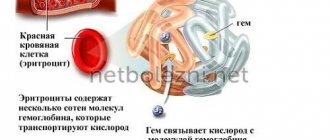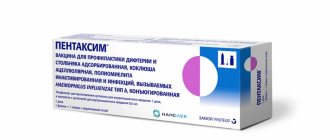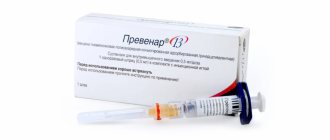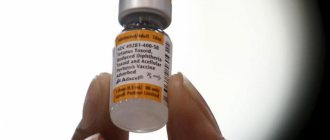To vaccinate or not?
The issue of childhood vaccinations causes perhaps the most heated debate among modern parents. “Vaccinators” appeal to the fact that vaccination is the only proven way to train the immune system to fight deadly infections, and it is obviously safer than a previous illness. “Anti-vaxxers” point out the unwanted side effects that are possible with vaccination. In fact, blindly following everything that is prescribed at the district clinic and categorically denying all the achievements of modern medicine are equally meaningless. Most parents would still like to make a balanced, informed decision. This means that each specific vaccine should be considered separately.
In this case, we are talking about vaccinating a child under one year old against whooping cough, diphtheria and tetanus. Is vaccination aimed at preventing these diseases justified?
Why vaccinate your child against tetanus?
Tetanus is extremely dangerous: the mortality rate from this disease reaches 80% of the number of cases, among newborns - 95%. The course of tetanus is very painful: there are known cases of such severe convulsions that the patient’s bones were broken. Even if the patient survives, immunity to tetanus does not develop after the illness, and it can be infected again, but the damage to the central nervous system is irreversible.
The causative agent of tetanus is found in the intestines of humans and animals, from where it enters the ground along with the feces or bodies of dead animals. Hence the widespread belief that it is impossible to become infected with tetanus if you do not play in places of mass burial of people or animals. This condition is unlikely to be met: the tetanus causative agent can persist in the soil for more than a hundred years, and the burial of domestic animals in Russia is often spontaneous.
PRIORIX
Manufacturer: Belgium
Live combination attenuated measles, mumps and rubella vaccine
Indications
active immunization against measles, mumps and rubella starting at 12 months of age.
Contraindications
- primary and secondary immunodeficiency;
- acute diseases and exacerbations of chronic diseases;
- pregnancy;
- hypersensitivity to neomycin and chicken egg white.
Side effect
Maybe:
- hyperemia at the injection site (7.2%),
- rash(7.1%),
- increase in temperature (6.4%),
- pain and swelling at the injection site (3.1% and 2.6%, respectively),
- swelling of the parotid salivary glands (0.7%),
- febrile seizures (0.1%).
In some cases:
- Development of symptoms characteristic of an upper respiratory tract infection (rhinitis, cough, bronchitis).
Why vaccinate your child against diphtheria?
Diphtheria (true croup, also known as “choking disease”) is transmitted by airborne droplets and is highly contagious. This is one of the diseases for which herd immunity is very important. Thus, since 1974, the disease was considered completely defeated thanks to mass vaccination, but in 1997, due to refusals to vaccinate, an outbreak of this disease was again recorded. Children are especially susceptible to diphtheria; about 25% of cases are very severe. As complications, diphtheria can cause paralysis, polyneuritis and myocarditis - inflammation of the heart muscle.
At the same time, diphtheria toxoid is one of the safest vaccines. Severe reactions to it are quite rare.
Drug interactions
In accordance with the rules adopted in Russia, Infanrix ® can be administered simultaneously (on the same day) with other vaccines of the National Preventive Vaccination Calendar and inactivated vaccines of the Preventive Vaccination Calendar for epidemic indications. However, other vaccines must be administered to other areas of the body.
Infanrix vaccine with the Hiberix ® vaccine (vaccine against Haemophilus influenzae type b). In this case, the solvent supplied with the Hiberix® vaccine should be replaced with the Infanrix ® vaccine.
Why vaccinate your child against whooping cough?
Whooping cough is especially dangerous for children under two years of age because it can cause respiratory failure. At the same time, whooping cough is one of those diseases for which antibodies against which are not transmitted through mother's milk, even if the mother was vaccinated or had whooping cough. Even having whooping cough does not provide lifelong immunity after recovery.
The mortality rate from whooping cough among those ill in the first year of life is 50-60%. In addition, whooping cough can cause complications such as pneumonia, cerebral hemorrhage, and rupture of the eardrum.
How does Infanrix differ from DTP?
“Anti-vaxxers” have perhaps the most complaints about the DTP vaccine among the entire range of vaccines that are administered to children in the first years of life. The reason for this is that DTP is quite difficult for children to tolerate. Many vaccinated people report high fever and poor health for several days after vaccination. Strong side effects are associated with the pertussis component of DTP - this is why neurologists and pediatricians recommend ADS-M instead of DTP for weakened children, that is, only diphtheria-tetanus toxoid, without whooping cough. Infanrix, unlike its domestic analogue, does not contain cells of the whooping cough pathogen.
To form an immune response, only three antigens (out of approximately three thousand) are extracted from these cells, which are used in the vaccine. This does not affect the effectiveness of Infanrix, but it is much less allergenic, much less often accompanied by fever and is easier to tolerate.
It also follows from this difference that during repeated vaccination or revaccination it is possible to switch to Infanrix after DTP, but vice versa is undesirable. If the first vaccinations contained only three antigens, you should not switch your child to a vaccine containing whole cells of the whooping cough pathogen.
Directions for use and doses
A single dose is 0.5 ml, contained in a specially designed syringe. This syringe dose of the Infanrix vaccine is aseptically packaged and adapted for convenient transportation and storage, equipped with a special needle that minimizes pain from the injection. The use of such a syringe eliminates overdose and reuse.
The Infanrix vaccine is administered intramuscularly into the thigh. Injection into the buttock is not currently practiced. Intravenous administration is strictly contraindicated.
Infanrix or Pentaxim?
Infanrix is not the only foreign-made vaccine that uses antigens isolated from the pertussis pathogen instead of whole cells. Pentaxim, also a very well-known foreign analogue of DPT, is produced using the same scheme. Which one should you choose?
They are very similar in composition and action, so it is logical to use the vaccine that is more accessible to you at the moment. However, there is one significant difference to consider. Infanrix contains only tetanus, whooping cough and diphtheria toxoids. Pentaxim, in addition, contains components for the prevention of hemophilus influenzae infection, as well as polio, that is, it is a five-component vaccine. This means that if you have already chosen Infanrix or Pentaxim, at the next vaccination or revaccination you will not be able to replace one with the other, since the vaccination protocol against polio and Haemophilus influenzae infection will not be completed to the end.
Should I combine all five components or get by with three, preferring Infanrix? The choice is up to the parents. Some believe that multicomponent vaccines create too high a one-time antigenic load on the body. Others rely on the National Vaccination Calendar, which provides for simultaneous vaccination against several diseases (without indicating how many vaccines are used). The Infanrix line has additional vaccines - Infanrix IPV (whooping cough, diphtheria, tetanus, polio) and even Infanrix Hexa (the same four diseases plus hepatitis B and hemophilus influenzae). The domestic DTP also has expanded options: Tetrakok (DTP + polio) and Bubo Kok (DTP + hepatitis B).
TETRAXIM
Composition of the Tetraxim vaccine
Tetraxim is a vaccine against whooping cough, diphtheria, tetanus and polio. One dose of the Tetraxim vaccine has the following composition:
- pertussis toxoid;
- diphtheria toxoid;
- tetanus toxoid;
- inactivated polio virus types 1, 2 and 3;
- hemagglutinin filamentous.
As excipients, Tetraxim contains water for injection, Hanks' medium, sodium hydroxide or acetic acid, formaldehyde, aluminum hydroxide and phenoxyethanol.
Complete with the Tetraxim vaccine suspension, the manufacturer provides a dosage syringe with a 0.5 milliliter needle attached. This form of release is quite convenient to use, since one package of the drug is applicable for one vaccinated person and an overdose is excluded. The Tetraxim vaccine is produced in France.
Tetraxim vaccination scheme
According to the current vaccination calendar, vaccination against diphtheria, whooping cough, polio and tetanus is carried out three times at the ages of three, four and a half and six months.
Tetraxim is administered intramuscularly into the middle part of the anterolateral thigh in children under two years of age or into the deltoid muscle on the shoulder in older children. You must first shake the solution to form a whitish, homogeneous, cloudy suspension.
Children aged 18 months are subject to revaccination after the initial course of Tetraxim, through a single administration.
Interaction of Tetraxim with other vaccinations
The peculiarity of Tetraxim is that it can be administered in the same syringe with the vaccine against Haemophilus influenzae and act as its solvent. Thus, only one injection is performed against a whole range of diseases, which reduces the emotional burden on the baby.
The instructions for use allow for vaccination simultaneously with the MMR vaccine (mumps, measles, rubella), against hepatitis B, and chickenpox. However, they must be injected into different areas of the body.
Contraindications for Tetraxim vaccination
There are a number of contraindications for administration of the Tetraxim vaccine or its analogues.
- Acute respiratory and infectious diseases, exacerbation of chronic foci of inflammation that occur against the background of elevated body temperature. In such situations, vaccination is postponed until the baby has fully recovered.
- Strong reactions that accompanied previous stages of vaccination.
- Encephalopathy that developed after previous vaccinations with drugs with pertussis antigen.
- Encephalopathy (decrease in the number of functioning brain cells) is progressive, with or without seizures.
- An allergic reaction that was noted after previously performed vaccinations of a similar type or to any component of the Tetraxim vaccine, as well as proven intolerance to glutaraldehyde, polymyxin B, neomycin, streptomycin.
Contraindications do not include convulsive syndrome due to a history of fever, which was noted not in the post-vaccination period, but as a result of diseases with fever.
Parental behavior before and after vaccination
In order to carry out the Tetraxim vaccination correctly and without complications, parents must adhere to certain rules.
- Immediately before the administration of a biological drug, it is imperative to visit a pediatrician or family doctor to identify contraindications to vaccination and clarify the baby’s condition.
- Inform medical personnel about previously encountered complications during the administration of biological drugs.
- Measure the child’s body temperature for three days after vaccination.
- If you have any suspicions about the condition of a vaccinated child, you must show him to a doctor.
- If possible, do not bathe the child on the first day or rub the injection site to avoid infection from penetrating through the injured skin.
Body reactions to the Tetraxim vaccine
All reactions to vaccinations are classified as follows:
- local reactions;
- are common;
- nonspecific;
- potential.
Among local reactions, the administration of Tetraxim in the first 48 hours after injection can provoke:
- redness or thickening at the site of administration of the biological drug, not exceeding two centimeters in diameter, and which goes away without treatment within 2-3 days;
- swelling of nearby joints (knee, elbow) on the injection side, which also goes away without any therapeutic action in the first five days;
- soreness at the injection site, which does not require auxiliary means to eliminate it and disappears in the first two days.
General reactions to Tetraxim vaccination include an increase in temperature within 38–40 °C in the rectum, in the armpits it is 1 °C lower.
Nonspecific reactions that can be caused by the Tetraxim vaccine include:
- drowsiness;
- irritability;
- decreased appetite;
- sleep disorder;
- inconsolable crying;
- dyspeptic syndrome (nausea, vomiting, loose stool);
- very rarely (less than 0.01%) a rash similar to urticaria, the appearance of angioedema, anaphylactic shock, lethargy, febrile (afebrile) convulsions, hypotension (decreased muscle tone) may occur.
If any reactions develop after the administration of Tetraxim or complications in the first few days, you must immediately consult a doctor to clarify the child’s condition.
If any reactions develop after the administration of Tetraxim or complications in the first few days, you must immediately consult a doctor to clarify the child’s condition.
Potential complications include reactions that may occur to a separate component in similar combination vaccines:
- during vaccination with tetanus toxoid - can cause brachial neuritis, Guillain-Barré syndrome;
- possible development of periods of apnea (temporary stoppage of breathing) in children born at less than 28 weeks of pregnancy;
- the pertussis component can provoke the development of collapse (a sharp drop in pressure).
The post-vaccination reactions and complications listed above are extremely rare and depend on the individual reactivity and characteristics of the child’s body.
Having analyzed the composition of Tetraxim and what the vaccination protects against, we can conclude that the severity of complications from diseases significantly exceeds the severity of reactions after vaccination.
Currently, a sufficient number of vaccines with different sets of components have been produced. Knowing what the Tetraxim vaccine is, you can choose its equivalent if the drug is not available in pharmacies. It is worth noting that there is no vaccine on the pharmaceutical market with identical properties and composition, but there are analogues with similar main components - diphtheria, whooping cough, tetanus with combinations.
How is Infanrix administered?
According to the National Vaccination Calendar, the first preventive immunization against tetanus, diphtheria and whooping cough is carried out at three months. As a rule, it is preceded by an examination of the child by a neurologist, who “gives the go-ahead” for vaccination or, on the contrary, a waiver from it according to indications, and then by a pediatrician.
Infanrix allows for shifts in the timing of vaccination in this case. This will not affect its effectiveness.
The second stage of immunization occurs at 4.5 months.
The third is for six months.
This first course of three procedures builds immunity a month after vaccination. Its effectiveness is 99% for diphtheria and tetanus, 95% for whooping cough.
Revaccination against whooping cough, diphtheria and tetanus is carried out at 18 months (one and a half years). During revaccination, a secondary response of the immune system is formed, which consolidates the effect of primary vaccination. Revaccination against diphtheria and tetanus is also given to children aged 7 and 14 years. In an adult, immunity against diphtheria and tetanus acquired as a result of vaccination lasts about 10 years.
INFANRIX
Manufacturer: Belgium
KFG: Vaccine for the prevention of diphtheria, tetanus, whooping cough
Clinical and pharmacological group: Vaccine for the prevention of diphtheria, tetanus, whooping cough.
pharmachologic effect
- Vaccine against diphtheria, tetanus and whooping cough.
- Immune response to primary immunization: After 1 month. after a three-dose course of primary vaccination carried out in the first 6 months of life, more than 99% of those immunized with the vaccine. Infanrix in children: antibody titers to diphtheria and tetanus toxoids are more than 0.1 IU/ml. Antibodies to pertussis antigens (pertussis toxoid /KA/, filamentous hemagglutinin /FHA/ and pertactin) are produced in more than 95% of vaccinated people.
- Immune response to revaccination: After revaccination with the Infanrix vaccine at the 2nd year of life (24 months), in all children who were primarily immunized with the Infanrix vaccine, antibody titers to diphtheria and tetanus toxoids are more than 0.1 IU/ml. A secondary immune response to pertussis antigens is observed in more than 96% of children.
- The protective effectiveness of the vaccine reaches an average of 88%.
Indications
- primary vaccination against diphtheria, tetanus and whooping cough in children from 3 months;
- revaccination of children who were previously immunized with 3 doses of acellular pertussis-diphtheria-tetanus or whole-cell pertussis-diphtheria-tetanus vaccine.
When starting a course of vaccination with whole-cell pertussis-diphtheria-tetanus vaccine, subsequent doses of acellular pertussis-diphtheria-tetanus vaccine can be administered and vice versa.
Dosage regimen
A single dose of the vaccine is 0.5 ml. The course of primary vaccination consists of 3 doses of vaccine administered according to the National Calendar of Preventive Vaccinations of Russia at 3, 4.5 and 6 months of life; revaccination is carried out at 18 months.
Before administration, the vaccine is shaken well until a homogeneous cloudy suspension is formed and examined carefully. If foreign particles, unbreakable flakes or changes in appearance are detected, the vaccine is not used.
The Infanrix vaccine is administered intramuscularly and alternate injection sites during the course of vaccination.
Infanrix vaccine should not be administered IV under any circumstances.
Side effects
The data studied indicate that the Infanrix vaccine has lower reactogenicity compared to whole-cell pertussis-diphtheria-tetanus vaccines.
- Very rare: allergic reactions, including anaphylactoid reactions.
- Extremely rare: collapse, shock-like states (hypotonic-hyporesponsive episodes) and convulsions within 2 to 3 days after vaccination (such side effects were transient and did not lead to any consequences).
Adverse reactions in the post-vaccination period during primary vaccination with Infanrix (based on studies covering 11,406 administered doses).
- Dermatological reactions: 1% - dermatitis.
- From the respiratory system: 3% - cough, rhinitis, bronchitis, other upper respiratory tract infections.
- Due to decreased susceptibility to infections: 1% - otitis media.
Adverse reactions following revaccination with Infanrix following primary vaccination with the same vaccine (based on studies covering 2,363 doses administered)
- From the respiratory system: 4% - cough, pharyngitis, bronchitis, other upper respiratory tract infections, rhinitis, respiratory failure.
- Due to resistance to infections: 3% - viral infection, otitis media.
Adverse reactions following booster vaccination with Infanrix following primary vaccination with whole-cell diphtheria-tetanus-pertussis vaccine (based on studies involving 606 administered doses).
- From the respiratory system: 3% - cough, pharyngitis, upper respiratory tract infections, bronchitis.
- Due to resistance to infections: 2% - otitis media.
Contraindications
- known hypersensitivity to any component of this vaccine, as well as if the patient has experienced symptoms of hypersensitivity after a previous administration of the Infanrix vaccine;
- severe reaction (temperature more than 40C, hyperemia or swelling more than 8 cm in diameter) or complication (collapse or shock-like state that developed within 48 hours after vaccine administration; continuous crying lasting 3 hours or more that occurred within 48 hours after vaccine administration ; convulsions, accompanied or not accompanied by a febrile state, that occurred within 3 days after vaccination) following the previous administration of the Infanrix vaccine;
- encephalopathy that developed within 7 days after the previous administration of a vaccine containing a pertussis component. In this case, the vaccination course should be continued with diphtheria-tetanus vaccine.
Possible side effects of Infanrix
The instructions for the drug mention the following side effects of the vaccine as the most common: drowsiness, loss of appetite, irritability, anxiety, fever, itching and swelling at the injection site, vomiting, diarrhea. Infrequently, vaccination may be followed by headache, cough, rash, or lump at the injection site.
Adverse reactions occurring in more than 1% of vaccinated people are considered frequent. Any vaccination can cause an allergic reaction. Therefore, after the vaccination is administered, it is not recommended to leave the clinic for 30-40 minutes: in any office where vaccinations are given, there is a first aid kit for a quick response to possible anaphylactic shock. After this time has passed, an acute allergic reaction to the drug will no longer occur, and you can safely go home.
If a child's temperature rises after vaccination, it is recommended to ventilate the room in which he is located and maintain a humidity level above 70%. At temperatures above 38.5 °C, it is better to give an antipyretic, and if it rises above 40 °C, you should immediately call an ambulance. Be sure to give your child more fluids.
If any of the adverse reactions persist for more than two days, you should consult a doctor. This can happen when vaccinated with a low-quality vaccine (improperly stored or expired) or if the vaccination itself was done incorrectly, with a violation of sterility.
INFANRIX HEXA
When the time comes to vaccinate a newborn baby, many parents do not think about the fact that they have the right to choose a vaccine. This is a very important point, since according to the national vaccination calendar, vaccination is carried out free of charge, using inexpensive drugs for this purpose, as a rule, domestically produced. But at the request of the parents, you can select other vaccines approved for use in the Russian Federation. In this case, you will have to pay the cost of the drug out of your own pocket.
We will not dwell now on the quality of domestic and imported drugs in general - this is a matter of personal preference. Below we will talk about the Infanrix Hexa vaccine (INFANRIX HEXA), primarily as a substitute for the domestic DTP and live polio vaccine. We will find out what is included in Infanrix Hexa, how the child tolerates the vaccination, whether it has side effects and what schedule to follow for vaccination.
Description of Infanrix Hexa
The vaccine is one of the modern complex drugs for the prevention of infectious diseases in children. GlaxoSmithKline is a British concern engaged in the development and production of vaccines and other medical products. The company has branches all over the world and ranks third among pharmaceutical manufacturers. In Russia there is a joint venture, SmithKline Beecham-Biomed LLC, where several types of vaccines are produced, but Infanrix Hexa is not yet one of them. Infanrix Hexa is produced at a pharmaceutical plant located in Belgium.
The Infanrix Hexa vaccine contains the following components:
- pertussis toxoid 25 mcg;
- diphtheria toxoid - 30 IU;
- tetanus toxoid - 40 IU;
- inactivated (killed) polio virus types 1, 2 and 3 - 40, 8 and 31 antigen units, respectively;
- hepatitis B antigen - 10 mcg;
- Hib component for bacterial diseases caused by Haemophilus influenzae - Haemophilus influenzae on tetanus toxoid.
As excipients and preservatives, the Infanrix Hexa vaccine contains aluminum compounds, special nutrient media, pertactin and sodium chloride. It does not contain mercury salts (merthiolate) or formaldehyde. Also, the Hib component of the drug contains the antibiotics polymyxin and neomycin, which is taken into account if the child has allergies.
The advantages of the Infanrix Hexa vaccine include the following:
- low reactogenicity due to the acellular pertussis component;
- absence of harmful preservatives;
- killed poliovirus - there is no risk of developing vaccine polio, the child is not a source of the virus after vaccination;
- convenient packaging - eliminates errors by medical staff;
- One injection contains six diseases at once - less stress for the child and fewer trips to the vaccination office.
Of all the disadvantages, the most significant is the high cost of the drug. In addition, as with any imported medicine, problems may arise with supplies to Russia.
What diseases is Infanrix Hexa vaccinated against?
The drug causes the development of immunity to six infectious diseases. What diseases are Infanrix Hexa used for?
- Polio.
- Hepatitis B.
- Tetanus.
- Whooping cough.
- Diphtheria.
- Haemophilus influenzae infection.
Instructions for use
The vaccine is intended to prevent six infectious diseases in children aged three months to five years. The vaccine consists of two components. A special syringe contains five components in the form of a suspension. Separately in the bottle there is a lyophilized (dried) Hib component. Before use, it is diluted with a suspension from a syringe and administered to the child using another needle.
According to the instructions, the Infanrix Hexa vaccine is administered intramuscularly into the quadriceps femoris muscle (in the middle third of the outer surface of the thigh).
Infanrix Hexa can be administered simultaneously with other approved vaccines, with the exception of BCG vaccination. Injections are given in different parts of the body. Co-administration does not affect the development of immunity in any way, and does not increase the number of cases of reaction to vaccination. Infanrix can also continue a course of vaccinations started with other vaccines, or replace it with other drugs during revaccinations.
Infanrix Hexa vaccination schedule
The Infanrix Hexa vaccination schedule is determined by the doctor based on the instructions for the drug and guided by the national vaccination calendar. It is advisable to use the vaccine at a time when several vaccinations against diseases included in Infanrix Hexa coincide according to the calendar (for example, vaccination at 6 months).
How many times is Infanrix Hexa administered if the entire vaccination course is focused only on it? The instructions recommend the following primary vaccination regimen:
- at 2–3–4 months;
- or 2–4–6 months;
- or 3–4–5 months.
Thus, the vaccine is administered three times in one dose. The interval between vaccinations should be at least one month. If vaccination is postponed for any reason, the next injections are given at intervals of 30–45 days.
Typically, the drug is used if the child has not received a full vaccination against hepatitis B. When choosing the timing of vaccination, the doctor is guided by the indications for vaccination against hepatitis B. Typically, this vaccination is given at birth, at 1 and 6 months. If required, hepatitis B is additionally vaccinated with another monovalent drug. If the child received a hepatitis B vaccine at birth, then Infanrix Hexa can be given at the age of 6–10–14 weeks.
Revaccination with Infanrix Hexa is carried out once, six months after the last injection, but no later than one and a half years of age. Some countries administer two doses of the vaccine at 3 and 5 months of age. In this option, revaccination is done between 11 and 13 months of the child’s life.
How to replace Infanrix Hexa? At the age of vaccination against whooping cough, diphtheria and tetanus, it is replaced with DTP vaccines - three-component Infanrix, Tetrakok. In other cases, it is replaced with Infanrix IPV Hib (DPT + polio + hemophilus influenzae infection), Infanrix Penta, Pentaxim. If necessary, DPT is combined with monovalent vaccines against hepatitis (for example, Engerix), with vaccinations against polio (Imovax Polio, Poliorix).
Contraindications
Infanrix Hexa has contraindications common to most inactivated vaccines:
- fever;
- acute diseases;
- chronic diseases in the acute stage;
- hypersensitivity to vaccine components;
- previously noted hypersensitive reaction to vaccination (shock, generalized allergy, damage to the nervous system);
- immunodeficiency states of the body (HIV, taking immunosuppressants, oncology).
Preparing for the Infanrix Hexa vaccination
The Infanrix Hexa vaccine does not have increased reactogenicity, so no preventive measures are required before vaccination. Of course, an absolutely healthy and seasoned baby will tolerate the vaccine more easily than a weak and sick one. Therefore, preparation for the Infanrix Hexa vaccination can be said to follow the rules of nutrition, sleep and wakefulness, daily walks and bathing.
Here are some recommendations from doctors that will help prevent accidental complications from any vaccination.
- At the time of vaccination, the child must be healthy, which is confirmed by blood and urine tests, examination by a pediatrician and neurologist.
- Three days before vaccination, do not give your baby unfamiliar food.
- In the morning before vaccination, do not allow your child to overeat; do not feed him an hour before vaccination (water is allowed without restrictions).
- Postpone vaccination if there are any unfavorable factors - extreme heat or cold, an upcoming long trip, a family event with a large number of guests, someone in the household has an acute respiratory infection, and so on.
Monitor your child closely the day before vaccination. The baby should have bowel movements, sleep and eat well, and be no more capricious than usual. If you are alarmed by something in your child’s behavior, it is better to play it safe and postpone the vaccination for a few days.
Reaction to Infanrix Hexa
A reaction to the Infanrix Hexa vaccine occurs on the day of vaccination or the next day. More often, the child reacts to the second and subsequent injections of the vaccine. Common (approximately 10% of cases from vaccinated children) are:
- loss of appetite;
- local reactions - pain, slight swelling and redness at the injection site;
- anxiety, irritability, tearfulness;
- temperature after vaccination with Infanrix Hexa, rising to 38–39.5 °C.
Elevated temperature after vaccination should be brought down with antipyretic drugs. An antipyretic should be given only if the temperature exceeds the norm. It is not necessary to use it for preventive purposes.
Less commonly (in 1% of cases) possible:
- vomit;
- diarrhea;
- swelling, compaction at the injection site larger than 5 cm;
- skin allergy in the form of itching.
Very rarely, in less than 0.01% of cases, the development of allergic reactions (urticaria, rash, dermatitis), cough, bronchitis, drowsiness, and convulsions is noted.
Sometimes, after the administration of Infanrix Hexa, a lump or diffuse swelling of the limb is formed. Swelling usually goes away in four days, induration - up to 10 days. If the reaction persists longer, you should consult a doctor.
Complications
Like all biologics, Infanrix Hexa has side effects. Less than 0.01% of vaccinated children developed serious complications:
- anaphylactic shock;
- hypotonic conditions;
- respiratory arrest;
- angioedema.
There are isolated reports of severe consequences of the Infanrix Hexa vaccine in children under the age of two years, although it is stipulated that a cause-and-effect relationship has not been established:
- paralysis;
- arthritis;
- encephalopathy;
- neuropathy;
- vasculitis;
- neuritis;
- Guillain-Barre disease;
- muscle weakness.
Cases of children dying from Infanrix Hexa have not been proven, although there were reports of this in the press in 2011–2012. The topic was also raised by opponents of vaccinations after a report presented to the Belgian government in December 2011.
How to prepare for Infanrix vaccination
The likelihood of adverse reactions occurring, as well as their severity, can be reduced by preparing for vaccination. First, you need to make sure that the child is healthy. Even a mild ARVI without fever is a temporary contraindication to vaccination. If the child is healthy, but one of the relatives who had contact with the child for several days before vaccination is sick, it is also better to reschedule the vaccination.
It is better to reschedule the vaccination if it is very hot outside or, conversely, very cold. In general, gentle conditions are indicated on the day of vaccination and for several days after. Stressful factors, including walking in the heat and cold, must be excluded.
It is recommended not to overload the stomach on the day of vaccination; vaccination should be done at least an hour after meals. On the day of vaccination, new complementary foods should not be introduced. It is recommended to pay attention to whether the child had bowel movements during the day before vaccination, and if not, give him an enema to help empty his bowels.
On the day the vaccination is scheduled, you can give your child an antihistamine.
special instructions
Before vaccination, you should study the child’s medical history, paying attention to previous administration of vaccines and the associated occurrence of adverse reactions, and also conduct an examination.
Administration of the vaccine should be postponed if the child has an acute illness accompanied by fever. In case of a mild infectious disease, vaccination can be carried out after the temperature has normalized.
As with any other vaccine, you should have everything you need ready to stop a possible anaphylactic reaction to Infanrix ®. Therefore, the vaccinated person must be under medical supervision for 30 minutes after immunization.
Infanrix should be used with caution in patients with thrombocytopenia or coagulation disorders, since in such patients, intramuscular injection may cause bleeding. To prevent bleeding, apply pressure to the injection site without rubbing it for at least 2 minutes.
HIV infection is not a contraindication to vaccination.
When the vaccine is administered to patients undergoing immunosuppressive therapy or to patients with immunodeficiency conditions, an adequate immune response may not be achieved.
If any of the side effects were temporarily associated with the administration of whole-cell or acellular diphtheria-tetanus-pertussis vaccine, the decision to administer subsequent doses should be carefully considered. Exceptions are possible under certain environmental conditions, such as a high incidence of whooping cough, when the potential benefits outweigh the possible risks, especially if these adverse reactions were not associated with persistent complications.
The following conditions were contraindications to the administration of whole-cell DTP vaccines and can be classified as general precautions, incl. when administering acellular DTP vaccines:
- temperature 40.5°C or higher within 48 hours after vaccination, not associated with reasons other than vaccine administration;
- collapse or shock-like state (hypotonic-hyporesponsive episode) that developed within 48 hours after vaccine administration;
- continuous crying, lasting 3 hours or more, occurring within 48 hours after administration of the vaccine;
- convulsions, accompanied or unaccompanied by a febrile state, occurring within 3 days after vaccination.
In children with progressive neurological disorders, including infantile spasms, uncontrolled epilepsy, or progressive encephalopathy, administration of pertussis vaccine (whole cell or acellular) should be delayed until the condition is stabilized. The decision to prescribe pertussis-containing vaccine should be made on an individual basis after a careful assessment of the benefits and risks.
A history of febrile seizures or a family history of seizures is not a contraindication, but requires special attention.
It is necessary to take into account the potential risk of apnea and the need to monitor respiratory function for 48-72 hours when conducting a course of primary vaccination in children born prematurely (≤ 28 weeks of gestation) and, especially, children with respiratory distress syndrome. Due to the need to vaccinate children in this group, vaccination should not be delayed or denied.






